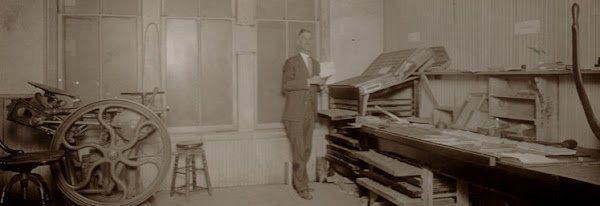This press was built by the M. M. Kelton Company of Brooklyn, NY sometime from the 1850’s through the early 20th century. I haven’t been able to pin it down closer than that and have found little direct information on these presses. However, by doing a lot of internet research, piecing together tidbits of information including that gleaned form vintage photos and etchings, and disassembly and studying the press as part of its restoration, I’ve learned quite a bit. For one thing, this style of cast iron mass-produced press was used extensively by bank note companies as well as the U.S. Bureau of Engraving and Printing throughout the latter half of the 19th century. One of the largest users in my own area was the American Bank Note Company which had a printing house in Brooklyn, NY in addition to it’s headquarters in Manhattan. Brooklyn is of course where my press was made. Below is a photo of the ABNC’s now closed Brooklyn plant as it looks today.

Another photo shows these presses in operation and there are dozens, maybe hundreds of them churning out paper money, certificates, stamps, and all manner of financial documents. These presses were not designed for artists but for production. The top cylinder was in fact only a half-cylinder, its cross section appearing as a D-shape. The bed had a weight attached to the back that in conjunction with a pulley kept the bed in the forward position. When turning the handwheel an adjustable cam on the right side of the cylinder engaged with an adjustable mating cam on the bed which started the bed through the two (upper and lower) rollers automatically. Intaglio presses use three felt blankets laid over the paper and plate in order to cushion the pressure and press the paper into the incised plate to pick up the ink. On this press, the top blanket is attached to the top cylinder and a bar at the rear of the bed holds the other two blankets that extend along the bed under the upper cylinder.

Additionally, there is an iron frame above the press with a cross bar on which is a pulley. The blankets attached at the rear of the bed are held together at the front end where a rope is attached that goes over this pulley and on the end of which is a weight. When the press is at rest the bed is in its forward (start) position and the front end of the blankets are held up in the air out if the way so the plate and paper can be laid on the bed. Then the handwheel is turned, the bed is engaged and goes between the rollers making the print at which point it is automatically released merely by continuing to turn the handwheel. The bed automatically returns to its forward position and the blankets are automatically drawn up out of the way so the proof can be removed. Anyone who has operated an intaglio press will recognize the time saved with this arrangement. While not necessary for artist’s proofs, it’s a definite advantage for meeting production deadlines.

The press is not large but it is heavy. This is partly because the upper cylinder is solid, and even though the lower cylinder is a hollow casting it is very large and has thick walls as you would expect on an intaglio press because of the pressure exerted during printing. Modern presses have rollers about the same size top and bottom but it was common in the 19th century for the bottom roller to be much larger than the top as is the case here. Altogether the press weighs between 300 and 400 pounds, though that’s just an estimate. In practical terms it will print a plate up to 8” x 10”. The presses most recent use was as a display item in a print shop in Long Island City, i.e. Queens. It had been coated in black paint right over any dirt and rust so it would be nice and shiny. It needs to be completly cleaned and adjusted, the paint taken off where it shouldn't be, and some minor repairs made but otherwise nothing major. I suspect it came from the ABNC in Brooklyn when they closed that plant which is not too far away from its display post.

I have several letterpress printing projects that are a priority at the moment but I’ve begun the restoration process on this press and hope to be able to experiment within a month or so. I’ve never done intaglio before so it will be interesting. Besides limited edition proofs, I want to use it to produce artwork for my letterpress journal and also for artistamps that I can perforate on my Rosback perforator. I’ve seen some examples of work that is a combination of intaglio and letterpress so there are a lot of options, even if I don’t have radioactive blood.



1 comment:
hi.. i have one of these presses also.. looks pretty much the same except it says thompson ? new york, n.y.. and my "star" wheel has an outside ring.
i've done some intaglio on it but mostly use my large etching press.
victoria
pleiades press
Post a Comment